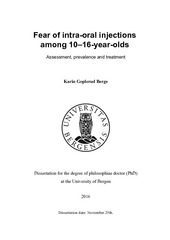| dc.contributor.author | Berge, Karin Goplerud | en_US |
| dc.date.accessioned | 2016-11-30T07:58:53Z | |
| dc.date.available | 2016-11-30T07:58:53Z | |
| dc.date.issued | 2016-11-25 | |
| dc.identifier.isbn | 978-82-308-3197-7 | en_US |
| dc.identifier.uri | https://hdl.handle.net/1956/13152 | |
| dc.description.abstract | Background: Intra-oral injections are common procedures within dentistry, performed in order to avoid procedural pain. Nevertheless, little is known about the prevalence of high intra-oral injection fear, or treatment of intra-oral injection phobia among children and adolescents. Aims: The overall aims were to gain more knowledge about the prevalence of high intra-oral injection fear among children and adolescents, to validate the novel Intra-Oral Injection Fear scale (IOIF-s), to clarify the overlap between intra-oral injection fear and dental fear, and to explore the possible effectiveness of cognitive behavior therapy (CBT) among children and adolescents with formally diagnosed intra-oral injection phobia (I-OIP). Methods: The study comprised two parts, both carried out in Hordaland County, Norway. Study I was a cross-sectional study among 1460 10- to 16-year old pupils. Data were collected by use of questionnaires, including the novel IOIF-s. Study II was a randomized and controlled treatment study in 67 patients within the same age group, fulfilling the DSM-5 criteria for I-OIP. The patients were randomly assigned to either an immediate treatment group receiving CBT, or a waitlist-control group. The treatment was performed by dentists specially trained in CBT. Subjective and behavioural measures of effectiveness of the treatment were assessed. Results: Crohnbach’s alpha of the IOIF-s was 0.95. Further the IOIF-s was found to discriminate between participants with and without I-OIP. In total 13.9% of the children reported high fear of intra-oral injections based on the IOIF-s. A strong association between fear of intra-oral injections and dental fear was revealed. CBT had significant effect compared to no treatment both measured subjectively by selfreport scales, and behaviourally by receiving intra-oral injections. Conclusions: The IOIF-s has satisfying psychometric properties in terms of reliability and validity. Further, high intra-oral injection fear was found to be prevalent among the targeted age group, and is associated with avoidance of necessary dental treatment. CBT performed by specially trained dentists is an efficient treatment among children and adolescents diagnosed with intra-oral injections. | en_US |
| dc.language.iso | eng | eng |
| dc.publisher | The University of Bergen | eng |
| dc.relation.haspart | Paper I: Berge KG, Vika M, Agdal ML, Lie SA, Skeie MS. Reliability, validity and cut-off score of the Intra-Oral Injection Fear scale, Int J Paediatr Dent. 2016. The article is available in the main thesis. The article is also available at: <a href="http://dx.doi.org/10.1111/ipd.12237" target="blank">http://dx.doi.org/10.1111/ipd.12237</a> | en_US |
| dc.relation.haspart | Paper II: Berge KG, Agdal ML, Vika M, Skeie MS. High fear of intra-oral injections: prevalence and relationship to dental fear and dental avoidance among 10-16-year-old children. Eur J Oral Sci. 2016, 124(6):572-579. The article is available in the main thesis. The article is also available at: <a href="http://dx.doi.org/10.1111/eos.12305" target="blank">http://dx.doi.org/10.1111/eos.12305</a> | en_US |
| dc.relation.haspart | Paper III: Berge KG, Agdal ML, Vika M, Skeie MS. Treatment of intra-oral injection phobia: a randomized clinical trial among 10- to 16-year-olds. Full text not available in BORA. | en_US |
| dc.title | Fear of intra-oral injections among 10-16-year-olds. Assessment, prevalence and treatment | en_US |
| dc.type | Doctoral thesis | |
| dc.rights.holder | Copyright the Author. All rights reserved | |
| dc.identifier.cristin | 1404769 | |
